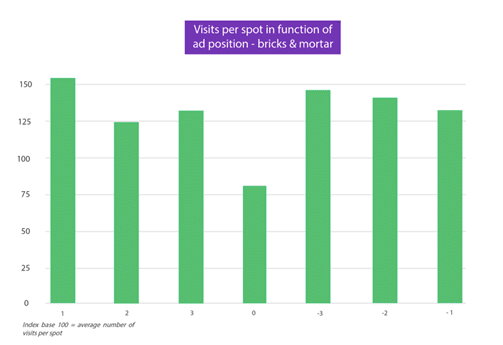
The study, from TV and radio analytics platform Admo.tv, examined the impact of TV adverts on online traffic in the UK.
Key findings:
- 70% of UK TV ads now run outside of the peak-time slot
- British TV viewers engage with adverts the most on Sundays – ads aired on this day are 17% more engaging than ads that run on any other day of the week
- For brick and mortar firms (traditional, high street brands), UK audiences engage most with the first advert of each advertising break – audience engagement often drops off after this
- In the UK TV ads are most engaging at an average 15 seconds in length – however, over 50% of UK TV spots remain significantly longer
The newly released data examines TV advertising trends for both brick and mortar brands (i.e. traditional, high street brands) and pure-players (i.e. online only, ecommerce brands). The data examines over 150,000 TV spots aired in the UK, and was captured between September 2018 and June 2019.
Daytime, not primetime – particularly for pure-player brands
The data indicates that for both pure-players and brick and mortar brands investing in TV ad spots, ‘day-time’ TV is now a preferred time of day for investment, with the primetime slot taking a much smaller share of purchased TV ad space. Furthermore, nearly 70% of all UK TV ads now run outside of the ‘peak-time’ period.
As a percentage of all TV ad spots that aired over the time period examined, 49% of the ads ran by pure-players aired during the ‘day-time’ slot. For traditional brick and mortar brands, only 13% of all TV ad slots aired during the late-peak period. For pure-players, this figure is even lower – only 11% of purchased ad spots ran during this ‘late-peak’ period.

Sunday the most popular day for TV advertising in the UK
Admo.tv has examined the average number of web visits that can be directly linked back to the airing of each TV advert (average number of visits per spot). This data, which is key to TV analytics business-driven performance approach, can be used to measure audience engagement with aired TV adverts.
The data indicates that British TV viewers engage with adverts the most on Sundays – the number of visits by spot on this day is 17% higher than the average level of engagement for the rest of the week. Sundays are closely followed by Mondays, whilst TV adverts ran on Wednesday-Friday typically receive the lowest levels of engagement with British TV audiences.
TV adverts ran by pure-players typically engage audiences more than adverts ran by traditional brick and mortar brands – adverts ran by pure-players outperform adverts ran by brick and mortar brands on 6 out of 7 days of the week.

When it comes to audience engagement, timing a spot during ad breaks is key – especially for brick and mortar brands. Brick and mortar brands benefit from buying ad spots that air immediately after an ad break begins – linkable web traffic for the first ad spot is 50% higher than at any other point during an ad break.
Engagement with TV ad spots typically halves at the middle-mark of an advertising break; this is a prominent trend affecting traditional brick and mortar brands and their TV advertising campaigns.
In contrast, audience engagement with TV ad spots ran by pure-players follows an opposing pattern. Engagement with adverts for these brands typically peaks in the middle of a TV advertising break. For pure-players, ad spots that air in central slots during an ad break are 8% more likely to lead to directly linkable web traffic.


TV adverts potentially too long for British audiences
UK audiences are most likely to engage with a TV advert when it is around 15 seconds long. Despite this, only 22% of TV ads aired in the UK market are of this length. In fact, over 50% of TV ads that air in the UK market last significantly longer.
This is most obvious with pure-players – 15-second long TV adverts for internet-only brands are roughly twice as engaging (in terms of directly linkable web traffic generated) as adverts that are 30 seconds in length.

Pierre Figeat, CEO and founder of Admo.tv, commented: “The TV landscape has changed beyond recognition – old market rules on ‘prime-time’ versus ‘day-time’, as well as the norms when it comes to standard TV ad length now appear to be redundant. As with any advertising campaign, business impact analysis, perhaps more so than any other metric, is now key.
To ensure that each TV advertising campaign is as effective as it can be, businesses must look to ensure the efficiency of a linear TV campaign based upon the online impact that each ad will have. Data analytics and attribution modelling are providing compelling insights for brands that go far beyond TV targeting analysis – the future is in what we call TV analytics business-driven performance measurement.
This is a user-centric analysis, based on the TV attribution model that identifies each online visitor coming from TV – fundamentally, this will help to ensure that each TV campaign delivers meaningful ROI. This is crucial for agencies, brands, buyers and planners as they strive to stay on top of rapidly changing TV audiences.”
